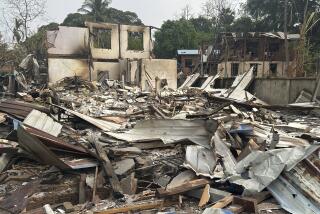U.N. Hopes 250 Pounds of Cash Is Last Payoff
- Share via
KISMAYU, Somalia — The twin-engine Beechcraft, code-named UNICEF Flight One, hit the runway hard Wednesday afternoon. It was laden with money--blood money. There were 100 million Somali shillings in all, worth about $25,000 and weighing 250 pounds in soiled bank notes.
It represented what Sean Devereux hoped would be the last extortion money the United Nations would have to pay to the armed clans and profiteering gangs that have held his agency hostage as it tried to save this coastal town.
Devereux, chief officer of the U.N. Children’s Fund in Kismayu, was dripping with sweat as he landed just after noon Thursday, hoping his Somali staff had sent him their “special technical”--the pickup truck with a rocket pod, ripped off from a vandalized MIG-21 fighter jet and mounted over the cab. But when he hit the ground in this, the latest outpost on the front line of the American-led military operation to save Somalia, Devereux found something far better: the U.S. Army and Air Force.
“Great, bloody hell! They’re here already!” the British U.N. worker shouted and beamed to a Times reporter accompanying him, as the UNICEF Beechcraft taxied toward a reconnaissance team of U.S. Special Forces troops and the Air Force’s Red Horse company of runway engineers. They had flown Thursday morning into Kismayu to pave the way for the U.S. Marines.
True, as the UNICEF plane arrived, the military team was just leaving, its groundwork completed. And the United Nations’ hired, rocket-pod pickup along with UNICEF’s hired gunmen--the local clansmen who will get more than half of the 100 million shillings Devereux had in tow--were waiting just outside the airport to escort him into town, a gutted, beachfront wreck with 150,000 people still living at gunpoint.
But Devereux’s joy was dramatic testimony to the impact of Operation Restore Hope, the U.N.-sanctioned military operation here at the cutting edge of Somalia’s war and famine.
The American force that greeted Devereux at the airport--where his planes in the past have been shot up and hijacked--offered evidence that war-torn Kismayu almost certainly is next on the U.S. military’s list of targets. It appeared to confirm accounts from several relief officials who said Kismayu will be occupied by U.S.-led forces in a matter of days.
In many ways, though, as Devereux knows better than most, Kismayu is even more desperate and more strategic than Baidoa, which was taken Wednesday without a shot as part of the military’s mission to help liberate starving, central Somalia from war and hunger.
Kismayu is a strategic port, idled for weeks after a U.N. shipment of 29,000 metric tons of wheat was hijacked by the agency’s own paid, local trucking contractors; taking this city will allow the relief effort to break through the worst of the Somali famine in the Juba River Valley to the north.
There are 48 villages in the Juba River between Jilib, just north of Kismayu, and the warlord-held town of Bardera, farther upriver. All have been inaccessible since the worst of the famine struck. The road is covered with land mines, and relief officials fear that the villages are blanketed with mass graves.
But even Kismayu, long cut off from any direct communication with the capital of Mogadishu far up the Indian Ocean coast, clearly cannot hold on much longer. After all, Devereux said, the town now houses 63,000 displaced people, who make up nearly half its population, and it already has suffered the worst fallout of the U.S. Marines’ arrival in Somalia.
“It happened the night before the Marines hit Mogadishu last Wednesday,” recalled Devereux, who was bunkered inside the UNICEF compound in Kismayu at the time. “Everyone here thought the Marines were going to land in Kismayu at the same time as Mogadishu. So the armed gangs here went on the rampage. . . . They killed 67 people and stole everything in sight.
“So, for this last week, we’ve got loads of people hiding in their houses.”
At midday Thursday, few people were visible on the war-pitted streets of the town; those who were around appeared to be armed. There also were many signs of Kismayu’s fractious, vicious army of “technicals.” That is the nickname that Western relief agencies have given both to armed individuals who man gun-laden trucks and other small vehicles and to the vehicles themselves, which look like those depicted in the “Mad Max” and “Road Warrior” science fiction films.
As in Baidoa and in Mogadishu--and as it will be in other Somali places where U.S. forces will arrive--Kismayu’s anarchy and violence have their own peculiar cast of characters. The biggest gun in Kismayu is its self-styled military leader, Col. Omar Jees. He broke away from the Somali army in 1988 and joined the rebellion against President Mohamed Siad Barre and his dictatorial regime.
That was a significant victory for the rebels at the time. Jees is an Ogaden clansman, as were those who followed him in his Somali Patriotic Movement. The colonel’s political group added strategic, geographic breadth to the growing military alliance of clans that ultimately succeeded in driving out Siad Barre and his forces in January, 1991.
The Ogaden were strong in Kismayu and easily drove out Siad Barre’s fleeing army and its Darod clan followers after the dictator fell. But, within days of Siad Barre’s ouster, a fractious alliance led by Gen. Mohammed Farah Aidid and his United Somali Congress exploded along clan lines. And in Kismayu, as in Mogadishu and Baidoa, Jees’ men and Aidid’s followers have been at loggerheads ever since.
“Col. Jees and his lot are a pretty respectable sort,” said Devereux, who has lived in Kismayu since September. “The problem is, he can’t control the (United Somali Congress forces) and Gen. Aidid is in Mogadishu, too far away to have any sway.”
As a result, the UNICEF project to supply food, high-protein supplements and medicine to feeding centers--along with the International Committee of the Red Cross and the two other brave, non-government agencies based in Kismayu--have been forced to pay vast sums to an array of heavily armed sub-clans.
“We’re paying through the nose every 15 days,” Devereux said angrily, echoing the sentiments of the three other relief agencies in town. “Look, we spend 400 million shillings a month--$100,000--to run our program. But, unfortunately, the vast majority of this has to go to car-hire and gas that are controlled by the gunmen, and, of course, to pay the gunmen themselves. Imagine, $20,000 a month to hire six cars, which are utter crap.”
To illustrate the extent of the extortion in Kismayu, Devereux recounted the time he attempted to change the water truck that the United Nations must hire to deliver drinkable supplies to the town’s feeding centers. He found a truck owner willing to deliver the supply for $100 less than the grossly inflated $400 per tanker rate that the United Nations had been paying.
But by the end of the first day, the new trucker had learned of the former rate, which he demanded of Devereux, threatening to kill him if he refused to pay it. Devereux complied; the next day, however, the truck owner besieged his compound with “technicals.” They sprayed the U.N. agency’s grounds with gunfire.
“Well, hopefully this is it--the last of it,” he said, pointing to the two large cartons stuffed with cash. “When the Marines land in Kismayu, it cuts our budget by more than half. And we’ll phase these so-called contracts out gradually until all the gunmen are gone.”
But Devereux’s optimism faded a bit when he met his UNICEF colleague on the ground. Johann Svensson had been holding the fort while Devereux went for the money. The Swedish U.N. worker shook his head as the U.S. Special Forces troops drove their Jeep up into the belly of a C-130 cargo plane.
“The situation is very bad in town at the moment,” he said.
He reported that there were heavily armed technicals roaming all over town. And, he added, the people were talking about one last war before Kismayu’s dawn.
More to Read
Sign up for Essential California
The most important California stories and recommendations in your inbox every morning.
You may occasionally receive promotional content from the Los Angeles Times.













